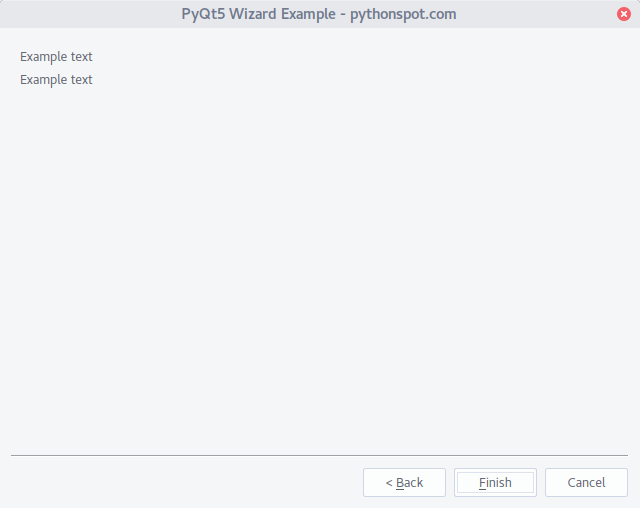Python hosting : Host, run, and code Python in the cloud!
A wizard is a screen you often see during installations, you have back and next buttons, and are guided through a process.
In PyQt5 these are called pages, every page can have some content. The buttons will guide you through these pages.
Related course:
Wizard Example
from PyQt5 import QtCorefrom PyQt5 import QtGuifrom PyQt5.QtCore import pyqtPropertyfrom PyQt5 import QtCore, QtWidgetsclass QIComboBox (QtWidgets.QComboBox ): def __init__ (self,parent=None ): super (QIComboBox, self).__init__(parent) class MagicWizard (QtWidgets.QWizard ): def __init__ (self, parent=None ): super (MagicWizard, self).__init__(parent) self.addPage(Page1(self)) self.addPage(Page2(self)) self.setWindowTitle("PyQt5 Wizard Example - pythonspot.com" ) self.resize(640 ,480 ) class Page1 (QtWidgets.QWizardPage ): def __init__ (self, parent=None ): super (Page1, self).__init__(parent) self.comboBox = QIComboBox(self) self.comboBox.addItem("Python" ,"/path/to/filename1" ) self.comboBox.addItem("PyQt5" ,"/path/to/filename2" ) layout = QtWidgets.QVBoxLayout() layout.addWidget(self.comboBox) self.setLayout(layout) class Page2 (QtWidgets.QWizardPage ): def __init__ (self, parent=None ): super (Page2, self).__init__(parent) self.label1 = QtWidgets.QLabel() self.label2 = QtWidgets.QLabel() layout = QtWidgets.QVBoxLayout() layout.addWidget(self.label1) layout.addWidget(self.label2) self.setLayout(layout) def initializePage (self ): self.label1.setText("Example text" ) self.label2.setText("Example text" ) if __name__ == '__main__' : import sys app = QtWidgets.QApplication(sys.argv) wizard = MagicWizard() wizard.show() sys.exit(app.exec_())
Screenshot:
For every page you can add a new class, where inside the method initializePage you can set the widgets. Inside the class MagicWizard add or remove pages.


Leave a Reply: